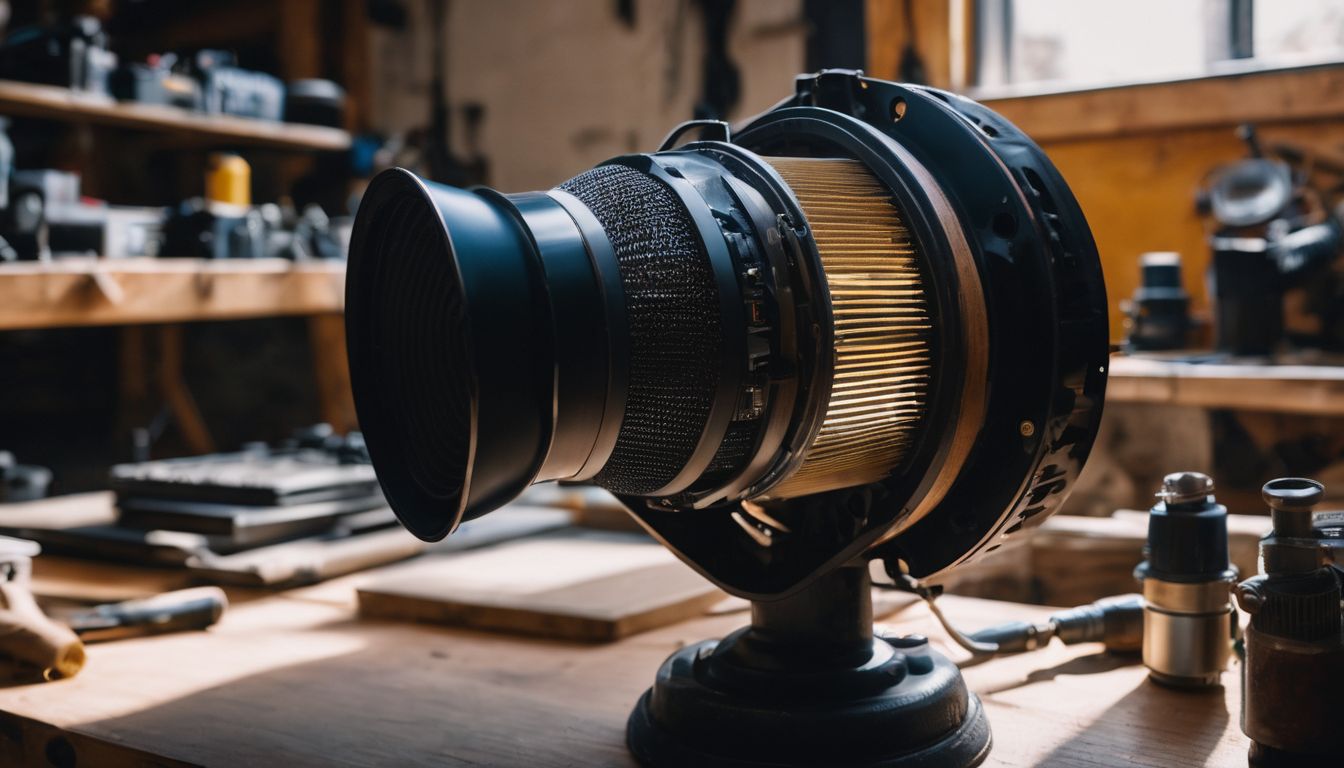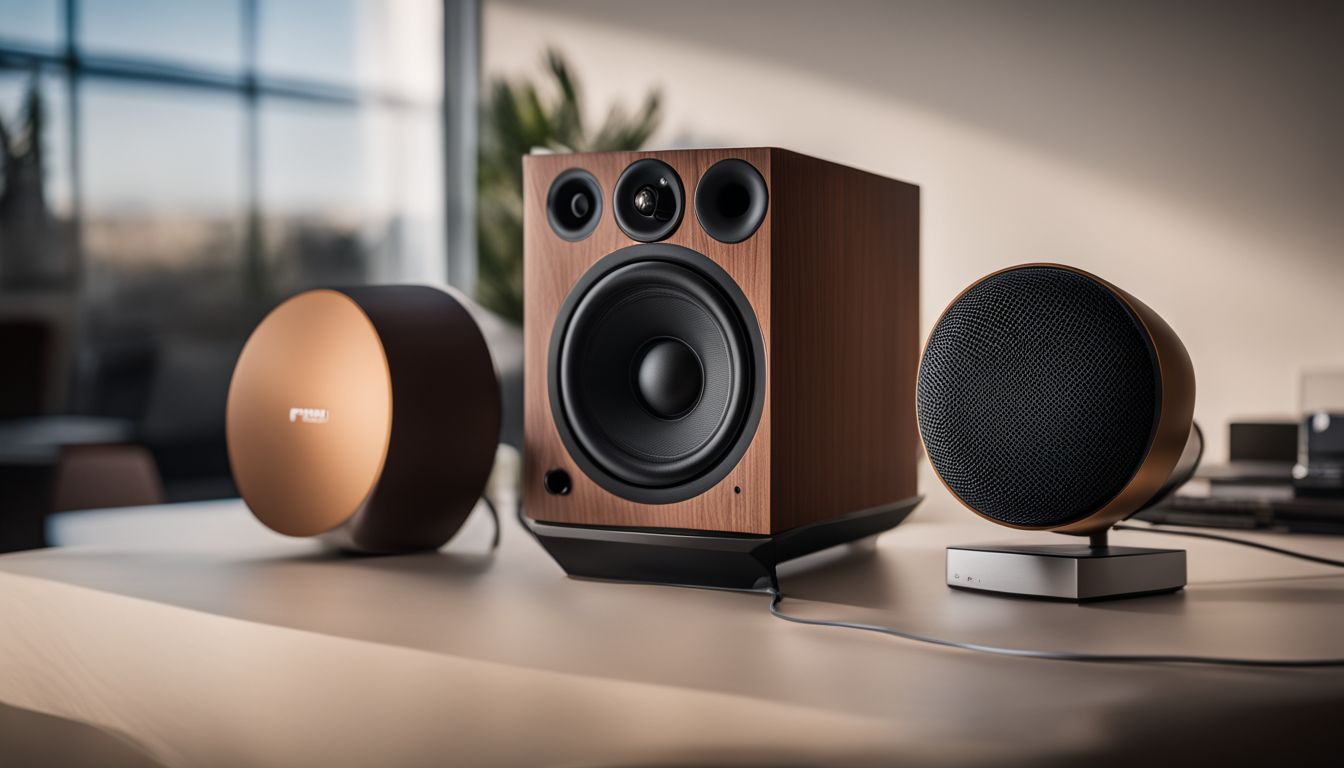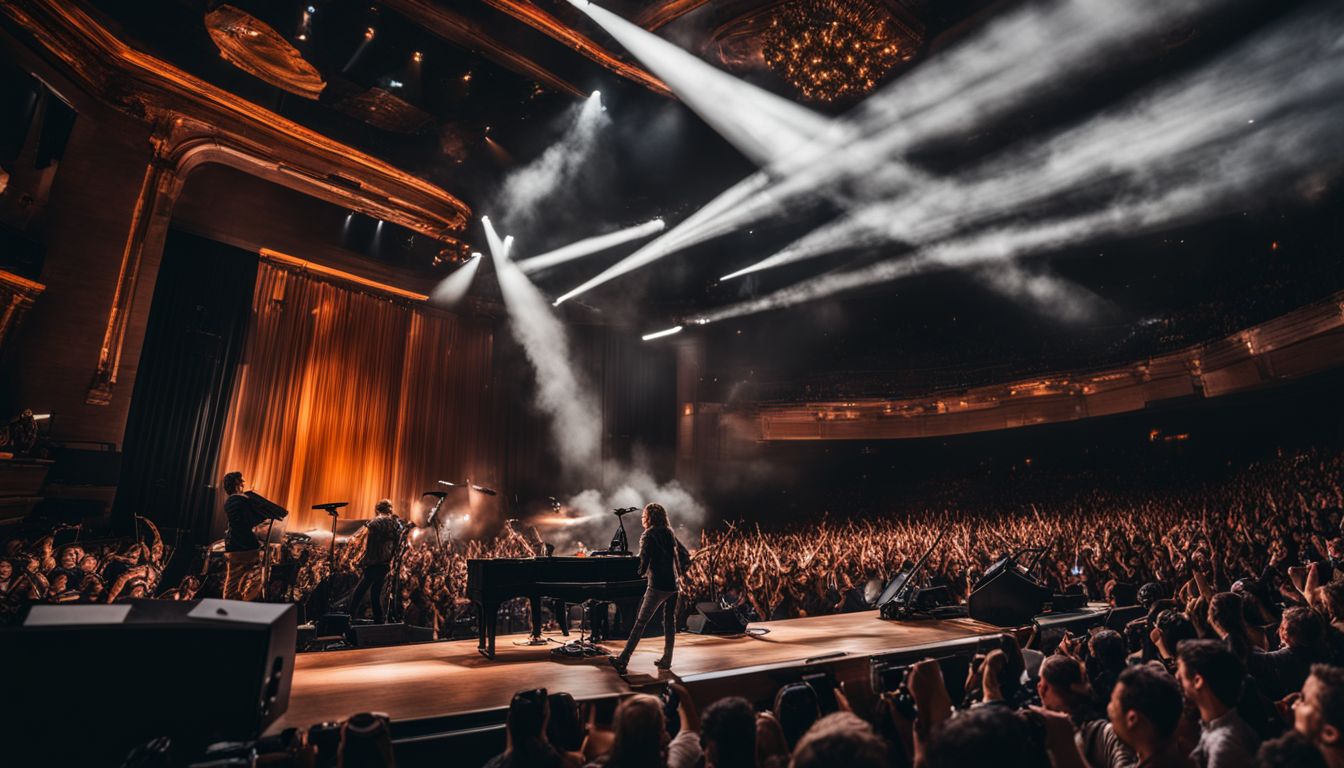Struggling to make your speakers hit those high-volume notes? You’re not alone; volume is a top concern when choosing the perfect sound system. This blog will guide you through the nuts and bolts of what pumps up the volume in speakers. It will give you practical insights to crank it up with confidence.
Dive in for some sound advice that’ll take your listening experience to new heights!
Key Takeaways
- To make speakers loud, high wattage is important, as it acts like a larger engine, allowing for more sound energy.
- A larger speaker generally produces a louder sound. They have more surface area to move air and create stronger sound waves.
- Speaker placement has a significant impact on volume. Placing them on the floor or against walls can amplify the sound through natural acoustics.
- Preamps are essential for raising weak audio levels and shaping the quality of the output. They ensure clarity at high volumes without distortion.
- Measuring loudness in decibels helps determine if speakers can produce enough power for different environments. It also helps maintain optimal balance.
Understanding the Basics of Speaker Operations
Every speaker turns electrical energy into sound by moving air. Inside, a magnet and voice coil work together. When electric current flows through the coil, it creates a magnetic field that pushes against the permanent magnet.
This motion moves the attached speaker cone back and forth rapidly. As the cone vibrates, it pumps out sound waves into the air around us.
The materials used in constructing a speaker greatly influence its performance. Lightweight cones, like those made from Kevlar, move more easily, making them responsive to subtle changes in music or dialogue. They also maintain durability.
Moreover, these components are housed within speaker enclosures. The enclosures are designed to amplify and direct sound pressure levels effectively without distortion. Proper enclosure design can significantly enhance bass response and overall sound fidelity. It creates an immersive listening experience. This applies whether for personal enjoyment or a public address system.
Moving on to what factors contribute to how loudspeakers can get.
Factors That Make Speakers Loud
Diving into the core of what amplifies sound, there’s a symphony of technical aspects that converge to boost a speaker’s volume. Raw power and design sophistication each play a critical role in magnifying and projecting sound waves across spaces.
Wattage
High wattage means your speakers have the potential to be loud. It’s like giving them a bigger engine for more sound energy. Every speaker has a maximum amount of power it can handle before the sound quality starts to degrade, or worse—the speaker gets damaged.
That total wattage figure tells you how much power your system can pump out without compromising on clarity or risking harm.
Choosing large speakers with high wattage allows you to experience louder and fuller sound that fills up a room. But it’s not just about picking any powerful loudspeaker system. These speakers must match the amplifier’s output for optimal performance.
When correctly paired, powerful amplifiers and high-wattage speakers work together in harmony. They deliver impressive volume levels and rich audio across different frequency ranges with ease.
Speaker Size
The size of a speaker plays a crucial role in its ability to produce a loud sound. Larger speakers generally have more surface area, which allows them to move more air. This creates stronger sound waves and results in higher volume levels.
This is why you’ll often find big speaker cabinets at concerts and events where filling a large space with powerful sound is key.
Inside these larger speakers, power handling increases. This is due to the greater capacity for larger voice coils and heavier magnets. This results in louder outputs without compromising on quality.
A speaker’s physical dimensions deliver robust sounds. Whether it’s booming bass or crystal-clear high frequencies,. The size of a speaker is crucial for packing a punch.
Cone Reflex
While speaker size does play a significant role in amplifying sound, the cone reflex also greatly influences how loud and clear that sound is. A well-designed cone not only moves more efficiently but also harnesses power to produce greater volumes without compromising sound quality.
This efficient movement means speakers can deliver punchy bass and crisp highs even at high volume levels.
Cone reflex mastery leads to speakers capable of handling increased wattage while maintaining audio fidelity. A flexible yet resilient cone pushes out robust sounds, ensuring that every beat hits with maximum impact.
Through precise engineering, loudspeaker systems leverage this aspect of design for optimal performance, allowing listeners to immerse themselves fully in an auditory experience that both captivates and energizes.
Insulation
Insulation in a speaker’s design is crucial for controlling sound quality. It stops noise from leaking out of the speaker box, ensuring that what you hear is pure, vibrant bass and clear trebles without any muddiness.
Good insulation can transform ordinary speakers into exceptional ones by enhancing overall resonance and delivering crisp audio.
Manufacturers often use specialized materials to insulate their loudspeaker enclosures. This isn’t just about keeping external noise at bay; it also minimizes vibrations that can distort sound as it moves through the air.
By carefully insulating the inside of the speaker boxes, they preserve sound integrity and create an acoustic environment similar to an anechoic chamber, where every note comes through exactly as intended.
Location
Location plays a critical role in how loud your speakers can sound. If you place them in large, open spaces, the room acoustics work to enhance the volume and clarity of the audio.
Sound waves have more room to travel and spread out before bouncing back, which makes for a richer listening experience. Conversely, smaller rooms or crowded areas might dampen sound or create awkward reflections that muddle what you hear.
Mind where you aim those speaker drivers, as directionality is key. Speakers facing walls or corners can leverage sound reinforcement systems by reflecting waves throughout the space for increased volume.
However, pointing them away from where you want the sound to focus could lessen their impact. Positioning matters; adjusting angles and experimenting with different spots in a room can significantly improve your speakers’ perceived loudness without tweaking any technical settings like frequency response or SPL (sound pressure level).
How to Enhance Speaker Loudness
Discovering ways to amplify your speakers’ volume isn’t just about cranking up the dial; strategic adjustments and a touch of acoustic savvy can unlock a whole new level of auditory bliss.
Let’s explore how you can squeeze out every decibel from your sound system without adding extra equipment.
Placement on the Floor
Placing your speakers on the floor isn’t just about convenience; it’s a strategic move to boost their performance. The solid surface acts as an amplifier. It enhances bass frequencies and contributes to the speaker’s overall loudness.
This method uses your space’s natural acoustics. It allows sound waves to spread more efficiently across the room.
Position your floor-standing speakers at points where they can breathe. Keep them away from stuffed corners that might muffle the sound. Optimizing placement is an easy and effective way to enrich your listening experience. You can do it without additional equipment or tweaks.
Loudspeaker drivers benefit greatly when given enough room to disperse sound evenly. This turns any ordinary space into an immersive audio environment.
Use of Multiple Bluetooth Speakers
Pairing multiple Bluetooth speakers together can create a more immersive sound experience. It can also make the sound more powerful. PartyCast technology lets you link up several devices to amp up the volume and fill any room with richer audio.
This method doesn’t rely on a single speaker. Instead, it distributes the sound across different areas. This ensures that everyone gets to enjoy high-fidelity music, no matter where they are in the space.
Taking advantage of this setup isn’t just about increased loudness. It also adds depth to your music by allowing for better distribution of audio frequencies. You’re effectively turning your environment into a live concert setting, with layers of sound coming from all directions.
Syncing multiple speakers is straightforward. Once done, it prepares you for an unparalleled listening experience. Next up: Positioning Against a Wall or Corner—find out how this simple trick can elevate your audio game even further.
Positioning Against a Wall or Corner
Placing your speaker against a wall boosts loudness significantly. This simple move works wonders. Sound waves reflect off the wall, increasing the sound pressure level that reaches your ears.
For even more impact, tuck the speaker into a corner where two walls meet. Here, sound waves bounce off multiple surfaces and amplify further without needing extra power.
Choosing the right spot is key for a small speaker with lower wattage to fill up a room with clear, quality sound. Strategic positioning can create an acoustic sweet spot where base notes thicken and melodies soar.
Experiment with the angles and directions of your speakers. Angling them slightly towards the center of the room often enhances audio performance.
The Role of Preamps in Speaker Loudness
Preamps act as the vital link that boosts audio signals before they hit the power amp. This boost is crucial for achieving higher speaker loudness without distortion.
- Preamps raise the level of weak audio inputs. As a result, they are powerful enough to pass through amplifiers and become louder through speakers.
- They shape sound quality by allowing listeners to customize bass, treble, and mid-range tones. Listeners can do this before amplification.
- With preamp control, you can fine-tune volume levels to match your listening environment or content. You won’t lose clarity at high volumes.
- By improving the signal-to-noise ratio, preamps ensure that even quiet details in music are heard clearly when played loud on speakers.
- Efficient driving of passive crossovers within speakers relies on a good preamp. It maintains crisp separation between different frequency bands.
- Next up, let’s dive into how measuring loudness plays into optimizing your listening experience.
Importance of Loudness Measurement
Measuring loudspeaker output isn’t just about achieving ear-splitting levels. It’s a critical step in ensuring your audio experience is both powerful and pleasant to the ear. Understanding decibels (dB) and sound pressure levels (SPL) empowers you. It helps you find that sweet spot where your speakers sing without distorting or causing discomfort. It maintains an optimal balance for immersive listening.
Decibels as a Measure of Loudness
Decibels, often abbreviated as dB, are the standard unit for measuring sound pressure level (SPL), which we perceive as loudness. They provide an objective way to describe how powerful or intense a sound is.
Imagine turning on your favorite song and feeling the floor shake. That sensation is thanks to waves of varying decibel levels hitting your ears. High decibel counts mean more power and, typically, more perceived volume.
Measuring speaker output in decibels allows us to objectively compare different audio devices’ ability to produce sound. It helps determine whether speakers can deliver the punch required for a home theater setup or if they’ll get lost outdoors during a block party.
Now that we understand decibels as a measure of loudness, let’s explore how finding the right volume keeps our music enjoyable. It also prevents harm to our hearing and disturbs others.
Determining Appropriate Loudness
Setting the right volume for your speakers is a bit like finding the perfect temperature—it’s all about balance. Cranking up those watts might seem like a straightforward path to louder audio, but it’s not just power that dictates how intense your sound will be.
Speaker size comes into play too, as larger cones can push out more air and create bigger sound waves, which translates to higher audible impact. It’s essential to match the speaker’s capabilities with its wattage. Underpowering or overpowering can result in distortion or damage.
Choosing the ideal loudness also means considering where you’re listening. In spacious rooms, you have more leeway to boost volume without overwhelming echoes muddying your music. Insulated boxes come to the rescue. They contain vibrations and increase sonic fidelity. This ensures cleaner output at various volumes.
Think of each space as unique; what rings true in one room may boom unpleasantly in another. Properly gauged loudness marries raw power with an environment’s acoustics. It creates an atmosphere where every note hits home without becoming a nuisance or losing quality.
Conclusion
Rocking out to your favorite tunes or immersing yourself in cinematic audio is all about loudspeakers that pack a punch. Thanks to the insights on wattage, size, and placement, amplifying your sound experience is now within reach.
Remember, louder isn’t always better; it’s about finding that sweet spot for your ears and space. Cranking up the volume to eleven might just be a matter of tweaking a few elements—no heavy lifting is required.
So go ahead, fine-tune those speakers, and let the good vibes roll!
To learn more about how preamps can boost your speaker’s volume, check out our detailed guide on what a preamp is and its role in loudness.
FAQs
What part of a speaker helps it produce a loud sound?
The dynamic loudspeaker’s cone drivers focus on the audio waves. Horn loudspeakers focus the audio waves too. This creates powerful, clear sounds. The sounds can be heard loudly.
How does speaker design affect volume levels?
Loudspeaker designs improve sound frequency and quality. They may include bass reflex ports and folded horns. This can make speakers sound louder without using more power.
Can different types of speakers, like piezoelectric or electrostatic models, get very loud?
Yes! Piezoelectric speakers use electrical charge to generate sound. Electrostatic loudspeakers vibrate thin panels to produce strong volumes. This is a different way from traditional moving-coil speakers.
What is an active crossover and how does it make speakers louder?
Active crossovers split audio signals into separate frequencies before they reach the amplifier. This ensures high-quality sounds come out more clearly at higher volumes from each driver, such as tweeters for highs and woofers for lows.
Do powered speakers have an advantage when it comes to volume?
Definitely! Powered speakers have built-in amplification. It boosts signal strength directly inside the speaker unit. This allows them to deliver louder sounds than those needing external amps.
What is the RMS power rating and why should I care about it for my speaker’s loudness?
The RMS power rating indicates how much continuous power a speaker can handle. Understanding this helps you match your speaker with an amp that won’t damage it but still lets you crank up the volume safely.


